
by Victoria Lucas
No.
No, no, no, no. no. I don’t believe it, can’t believe it, am not going to believe it.

Paul McCartney
Longer than the road that stretches Out ahead."
Continue reading [May 24, 1970] Let It Be (The Beatles break up)

by Victoria Lucas
No.
No, no, no, no. no. I don’t believe it, can’t believe it, am not going to believe it.

Paul McCartney
Continue reading [May 24, 1970] Let It Be (The Beatles break up)

By Mx Kris Vyas-Myall
Among musicians right now, there seems to be a split around whether to look towards an experimental future or an idealized past for their inspiration.
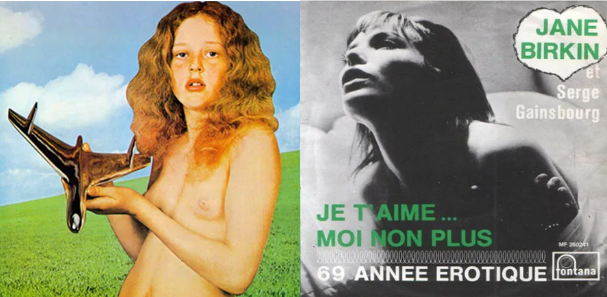
Both in pop music and SF, nudity and sex remain sources of controversy.
The most explicit examples of Futurism come from two recent singles, Zager and Evans’ In the Year 2525 and David Bowie’s Space Oddity. But there is also the debut album from King Crimson, featuring the song 21st Century Schizoid Man, The Moody Blues’ space inspired LP, and Pink Floyd performed a new piece recently in honour of the Moon Landing. In addition, the music industry is pushing what is acceptable sexually whether that be in artwork, such as the Blind Faith cover above, or interesting choices of sounds on pop songs.
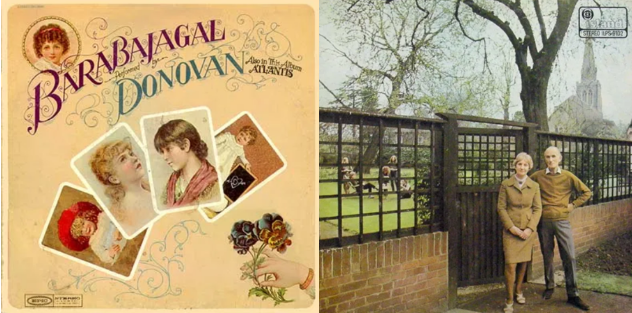
Did the Kinks have a point about preserving village greens?
On the other hand, at this time last month 4 of the top 5 singles were all country influenced songs, from Bobbie Gentry, Creedence Clearwater Revival, Johnny Cash and Bob Dylan. Now, there has always been some country influence in the charts (as shown by Jim Reeves having 7 posthumous top 20 singles and counting) but it is certainly reaching a new level when the Beach Boys and Rolling Stones are both trying it out. In addition, folk is also growing, often with a nostalgic edge, in such songs as Fairport Convention’s Who Knows Where the Time Goes or Donovan’s Atlantis.
These differences can also be seen in SF and, perhaps, there is no clearer division than that which can be observed between the two publications I am reviewing today.
The New S.F., ed. by Langdon Jones
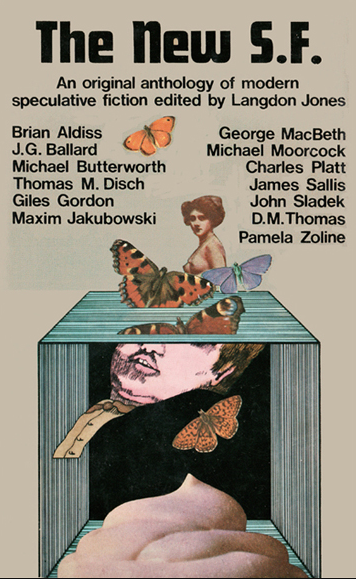
Cover by Colin Mier
An introduction by Michael Moorcock
Who else would you choose but Moorcock to introduce this selection of New Wave authors? Here he talks about how the “new SF writers” or “New Worlds group” have moved beyond spaceships and monsters to do more person-centric poetic pieces.
Fourteen Stations on the Northern Line by Giles Gordon
Fourteen different men observe an unnamed woman to different degrees of lechery as she walks up a hill. She fails to notice them as she has other things on her mind.
If it was not in this collection, it would probably not be considered SF, more akin to a Joyce than a Gernsback, only approaching the latter with the surrealism of the mind.
Moorcock’s introduction notes this as an example of a “compacted novel”, one that could be extended to a traditional novel but that would blunt the impact significantly. I cannot determine if I wanted this to be longer, shorter or reworked, but something is amiss. The metaphor, though obvious, is a good one (what passenger on a train pays attention to the small commuter stations?) and the difference in the inner lives of the observer and observed make a solid basis. But it left me wanting something better from it.
Three Stars
The Peking Junction by Michael Moorcock
A Jerry Cornelius story from his creator. In this episode, Europe has been devastated by American bombs (of course Europe still supports their allies in this action) and our dandified spy goes to China to deal with a downed American plane. His mission is complicated by the fact that he falls in love with one of the Chinese generals.
One interesting element here is Moorcock explicitly calls out the connection between Cornelius and his other tales:
Having been Elric, Asquiol, Minos, Aquilinus, Clovis Marca, now and forever he was Jerry Cornelius of the noble price, proud prince of ruins, boss of the circuits. Faustaff, Muldoon, the eternal champion…
There was always a suggestion of this previously, and The Blood Red Game (Science Fiction Adventures, 1963) and A Cure for Cancer both feature multiple universes, but I believe this is the first time we get it confirmed that this is not simply a case of repeated motifs.
Looking at it in this manner, we see the biting contemporary satire evolving into a more epic struggle and Moorcock’s other heroes as more than just throwaway fantasy figures. Rather there is a degree of tragedy in them having to deal with these various forces of order and chaos, making horrific choices for, what they hope, is the greater good (which rarely ends well).
A High Four Stars
Fast Car Wash by George MacBeth
A car gets cleaned… that is the entire story.
Moorcock calls this a readymade poem. I am assuming forthcoming are also a transcription of microwave instructions and George MacBeth’s shopping list.
One star
The Anxiety in the Eyes of the Cricket by James Sallis
Another Jerry Cornelius story, who is seemingly becoming to the New Wave what the Cthulhu tales have become to SF horror. This vignette apparently takes place shortly after the end of The Peking Junction (although Moorcock indicates this is better read as an alternative version) as JC returns to England a broken man. He stays in the house of his friend Michael, a man who predicted the apocalyptic future. They spend their time drinking and having sex between watching devastation from their window and discussing the nature of guilt.
A much quieter tale and more introspective than the other Cornelius tales with a good dose of narrative experimentation (if Michael is not surnamed Moorcock, I will eat my hat) added in. It is also incredibly bleak, with cities burning, Britain used as America’s crematorium, and Cornelius a broken man now simply looking for his missing family. But it is all the more powerful for it.
Five Stars
The New Science Fiction: A Conversation between J. G. Ballard & George MacBeth
This is the transcription of part of a discussion on BBC Radio 3 (formerly the Third Programme) last year titled The New Surrealism. In this extract, J. G. Ballard explains why he moved away from linear storytelling.
I missed this on its broadcast and I am very pleased it was reproduced here. Ballard manages to explain eloquently what he is trying to achieve in his stories and it has given me an increased appreciation for his work. Two sections I want to call out here as particularly incisive:
…one has many layers, many levels of experience going on at the same time. On one level might be the world of public events, Cape Kennedy, Vietnam, political life, on another level the immediate personal environment, the rooms we occupy, the postures we assume. On a third level, the inner world of the mind. All these levels are, as far as I can see them, equally fictional, and it is where these levels interact that one gets the only kind of inner reality that in fact exists nowadays.
…Burroughs’s narrative techniques… [are] an immediately recognisable reflection of the way life is actually experienced, that we live in quantified non-linear terms – we switch on television sets, switch them off half an hour later, speak on the telephone, read magazines, dream, and so forth. We don’t live our lives in linear terms in the sense that Victorians did.
Recommended for fans and confused readers alike.
Five Stars
So Far from Prague by Brian W. Aldiss
Another of Aldiss’ tales of Europeans in India. This time Slansky, a Czech filmmaker, is staying in a Das’ hotel outside Delhi when he hears of the Soviet invasion, He wants to get back home to help resist the attack, Das thinks they should be concentrating on their joint film project on the nature of time. Things get even more complicated when Slansky discovers there is a Russian guest in the room below his.
Interestingly, this manages a similar feel to Sallis’ piece even though it is contemporary rather than apocalyptic and could only be considered SFnal in the broadest sense. Here it is an exploration of the age-old argument of whether art can or should be apolitical, with this sense of gloom and despair. An important reminder that worlds are being blown up outside our window, not just in our magazines.
Four Stars
Direction by Charles Platt
An unnamed man has an argument at home. In response he gets drunk in a pub and then wanders around London in an inebriated haze.
Another piece where I am not sure the point of it, nor what it is doing in an SF anthology. There are some interesting writing techniques but that is all I can see to recommend it.
A low two stars
Postatomic by Michael Butterworth
We are told of four impossible beings, who may or may not be the same character across different time periods.
Not sure what its purpose is but it is certainly evocative.
Three Stars
For Thomas Tompion by Michael Moorcock
Moorcock completes his trilogy of entries with a four-line poem, addressed to the father of English clock-making.
Simple but well done for what it is.
Three stars
A Science Fiction Story for Joni Mitchell by Maxim Jakubowski
A science fiction writer has grown dissatisfied with the genre; instead he wants to write neo-psychedelic pop songs and tales of drug journeys. However, he has a deadline to hit, and the adventures of Coit Kid vs. the Subliminal Police don’t write themselves. Anyway, there is no chance of his other ideas intruding on a good old-fashioned science fiction story, is there?
A hilarious take on writing, modern pop music and science fiction cliches. It is done in a series of cut up pieces but logical rather than disparate. The whole exercise is delicious and I am going to be remembering many of the lines for some time.
Five Stars
The Communicants by John Sladek
This novella is a fragmented narrative, telling of a disparate set of people who work at Drum Inc., a technology company which provides a wide variety of services over phone lines and dreams of superseding Bell as the national monopoly.
Members of this organisation include Marilyn, who keeps getting mysterious calls that simply say “Marilyn, he loves you”, Sam Kravon, who is being driven mad by his job in Estimates, Phil Wang, the Art Director who is sure people are questioning his loyalty to the US, Ray, a cripple who is being constantly shuffled between departments, and David, who believes reality is refrangible.
At the same time, there are hints of experiments going on within the company that are of interest to the CIA.
Partially this is an extension of his multiple-choice form tales from New Worlds, with these regularly interrupting the text. And partially this is an experiment of split narratives, with the narrative like a butterfly flitting between different stories with such regularity that I wondered if I could use a flow chart.
Whilst it is an interesting experiment, it goes on for far too long (at almost 70 pages, far longer than anything else in this collection) and the whole is less than the sum of its parts.
Three Stars
Seeking a Suitable Donor by D. M. Thomas
An organ donor before their surgery contemplates his journey to this point.
The strange alignment of the text doesn’t add much to this tale of familiar themes but a perfectly reasonable example.
Three Stars
The Holland of the Mind by Pamela Zoline
Graham, Jessica and their child Rachel take a holiday from the US to Amsterdam in 1963. However, visiting the Venice of the North is not going to help them outrun their problems.
This is a tricky one to review. On the one hand it is beautifully written but shocking look at depression and the breakdown of a marriage, counterpointing the history of the Netherlands with their personal situation.
On the other, it is barely SFnal. There is one moment towards the end which could be taken as such. But it could also be taken as metaphorical and\or natural phenomena. As such I was partially disappointed. It reminded me somewhat of Morris’ travelogue Venice.
However, I adore Morris’ writing. As such I am happy to give it the benefit of the doubt and judge it as a piece of literary short fiction. On those grounds it is brilliant.
Five Stars
Quincunx by Thomas M. Disch
As the name suggests, this is made up of five vignettes:
• Chrysanthemums: Mr. Candolle ponders the meaning of chrysanthemums in hospital rooms
• Representation: The narrator speaks of his lost love Judith
• The Death of Lurleen Wallace: A circular tale of princes, presidential campaigns and books
• Mate: A letter from former lovers which also deals with a correspondence chess match
• The Assumption: Miss Lockesly teaches her class about death
I am not sure though what shape we are meant to form. To some extent they are all about endings in different ways but no consensus is reached nor are they particularly profound.
Two Stars
Thus ends this experiment of a book, one which I have rated all over the place. To change a famous quote, there is a thin line between genius and drivel. This anthology erases it.
Vision of Tomorrow #2
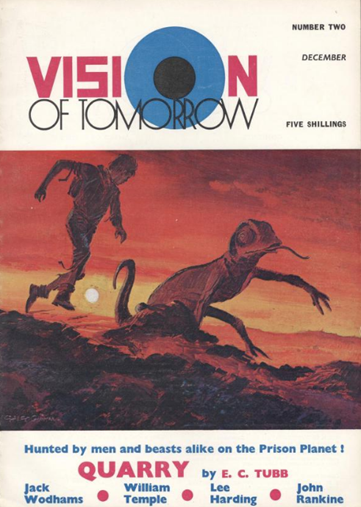
Cover Illustration: Gerard Alfo Quinn
Issue #2 has finally arrived. No explanation is given for the delay other than “circumstances beyond our control”. Whatever the reason, we shall now dive into the contents:
Quarry by E. C. Tubb

Illustrated by Gerard Alfo Quinn
Quelto Daruti is a prisoner of the Federation. he decides to make use of an obscure law. The Quarry-Hunt. He is to be hunted across the harsh landscape of Zen to sanctuary. If he can make it alive, he will be pardoned, but the only person who ever managed it before died of their wounds soon afterwards.
Durati however has two advantages the authorities do not know about. Firstly, he is a telepath. Secondly, the Terran league are very interested in his survival
Yes, it is yet another spin on The Most Dangerous Game, but a pretty good one. Stylistically it can be heavy at times, but this is made up for when it is action packed.
Just sneaks in at four stars.
Strictly Legal by Douglas Fulthorpe
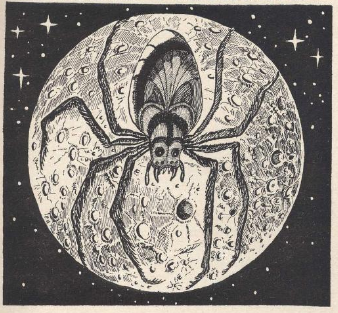
Illustrated by James
The intelligent spider-creatures of Proxima Centauri claim ownership of Earth’s Moon, on the grounds that it detached from one of their planets when it was molten. At first everyone assumes this is a joke. However, it turns out they are in deadly earnest, and the legal implications of the case will have devastating consequences.
This is a slippery slope argument delivered with all the subtlety of a brick through a window. The style is readable enough, but it requires so many “what-ifs” to make the idea work, I am not surprised everyone inside this piece of fiction assumes it is all a joke.
Two Stars
Moonchip by John Rankine
Millenia ago a small piece of metal fell to Earth. It has now been mined and ended up part of a car, one that is involved in a strangely high number of fatal accidents. But that is just coincidence, right?
I found this to be a dull and violent tale with little purpose. Maybe if you enjoy hoary old horror stories or car-based fiction it will appeal to you, but not to me.
One Star
A Judge of Men by Michael G. Coney
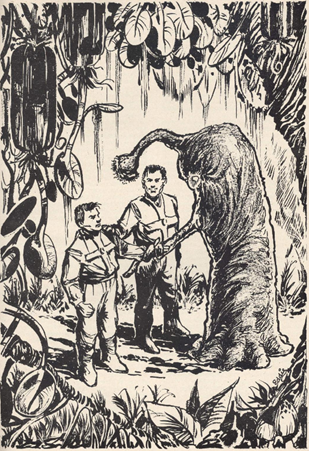
Illustrated by Eddie Jones
Scott travels with the trader Bancroft to the planet Karumba, the only source of Shroom (a kind of puff ball that can be woven) in the galaxy. The Shroom harvest is lessening as the planet gets colder and Karumbans may face extinction. However, having seen how humans treat animals in zoos, they refuse to allow any scientific help from humanity. Bancroft is willing to respect the Kamburans' wishes, the young ambitious Scott, however, is determined to solve the mysteries of this world, no matter what anyone else may think.
This did not go in the direction I expected. This started out seeming like it was merely going to be an experiment in xenobiology and the effects of planetary tilt but it went into much deeper territory around what it means to be a person, respect for native belief systems and the responsibility of ethical science.
My only complaint is it was too short to address all of the areas it touched on properly. I would love to see it expanded into one-half of an Ace Double.
A high four stars
Frozen Assets by Dan Morgan
Larry is a used air-car salesman who, with his fiancée Olivia is determined to find a way to get rich quick according to their realist philosophy. The first scheme involves being married to a wealthy divorcee but it turns out the pre-nuptial agreement states that Olivia won’t get any money from accidental death until after five years.
Larry then discovers there is a cure for cirrhosis of the liver, a condition his rich uncle Frank was cryogenically frozen with. He hopes to revive Frank and take control of his estate, however Frank is not quite as witless as Larry supposes.
This is the kind of story I dislike. It requires the setting up of a series of silly rules people follow, explaining them as they go along. In addition, it wends all over the place, barely sticking in one place for more than a moment.
One star
The Impatient Dreamers 2: Aims and Objects by Walter Gillings
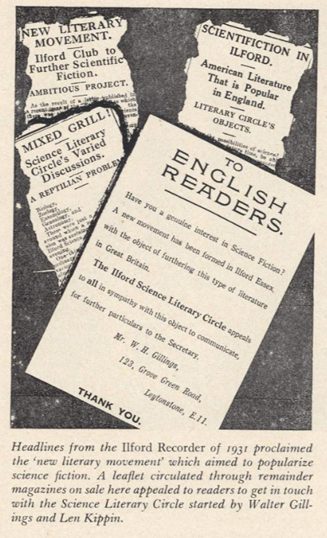
Filling in the gap between installments 1 and 3, we learn of Gillings' efforts to show that there is a strong enough market for science fiction in Britain to support a magazine.
This series continues to be excellent and contains a lot of fascinating details. Such as that Britain at this time didn’t have specialist fiction magazines at all and that Len Kippin just would hand out leaflets wherever he saw SF on sale.
Five Stars
Echo by William F. Temple
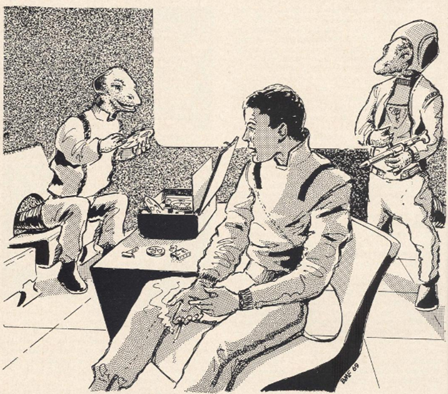
Illustrated by B. M. Finch
The Saurian Venusians have taken over the body of Richard Gaunt by use of a temporary echo of the personality of Narvel. They intend to steal the secrets of Organic Materials Inc., however, it turns out that being a human is harder than it seems.
I actually covered this last year in Famous, and I was planning to just reprint my review from there. However, curiosity got the better of me and I decided to look for any changes. I was taken aback that it was almost entirely rewritten. The plot remains identical but the prose is almost a complete overhaul. To compare one of the more similar sections:
Famous version:
Being a mammal, without previous experience, was to me a series of surprises, mostly unpleasant.
Gaunt, I knew, had the social habit of drinking whiskey. I first drank whiskey on the Pacific with a couple of engineers from Minneapolis.
After a while, I remarked with some concern. “Darn, it, the grav-motors are failing.”
This sometimes happened on space trips, and until they were repaired everyone had to endure free fall. I’d felt the beginning of free fall coming on; at least, I felt I was beginning to float. And I said so.
The two men looked at me strangely, then at each other.
“One whiskey on the rocks and he’s floating,” laughed one.
And the Vision version:
I became a Tyro mammal among experienced mammals.
My deficiencies first began to show on the spaceship to Earth. On the passenger list I was Richard Gaunt. I was Gaunt, physically. I did my best to act like him personally.
I knew he had this social habit of drinking whisky. I gave it a whirl at the bar with an engineer from Minneapolis.
After two whiskies, I remarked, ‘What’s gone wrong with the grav-motors?’
My companion looked at me strangely.
‘They seem okay to me. Sure I’s not the whisky hitting you? This special space brew is potent, you know, if you’re not used to it.’
Now, the scene being depicted has the same purpose: Narvel giving an example of not being used to certain human situations with impersonating Gaunt by his lack of familiarity with Whisky causing him to think there is an issue with the grav-motors. But the feel is completely changed. The prior version is concentrating on feelings and giving it a more comedic sense. The new version is more cerebral and philosophical about the nature of identity.
I still have a number of problems with the text but the changes make it clearer to me what he is trying to do. As such it jumps up a little bit in my ratings.
A low three stars
Undercover Weapon by Jack Wodhams

Illustrated by James
The Fiberphut fabric disintegrator was developed as a means of removing bandages without damaging the skin underneath. When the army look to test its possible military applications, Lt. Cladwell makes his own duplicate model at home. He and his brother-in-law are determined to make a fortune from this device…along with many amorous encounters along the way.
This is the kind of unfunny sex comedy that seem to be growing in popularity at the cinema these days. I don’t like it there and I don’t like it here. I am a little surprised to see this included given last month’s stated “no pornography” policy, but I guess as nothing is described it is considered “good clean fun” by Harbottle. I, on the other hand, find it lecherous and dull.
One Star
Dancing Gerontius by Lee Harding
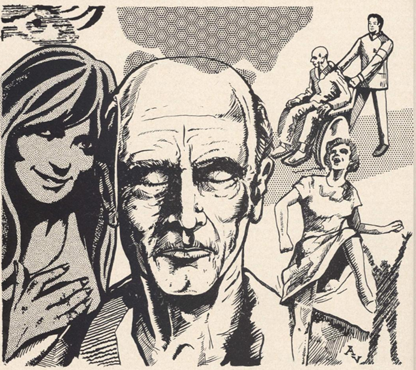
Illustrated by A. Vince
The elderly on welfare are generally kept in a dream-like state in specialist facilities. However, annually they participate in Year Day, where a combination of drugs and advanced machinery allow them to participate in a period of bacchanalian hedonism. We follow Berensen’s experiences as he is crowned King for the day.
An evocative piece that did not go in the direction I expected it to. Quite haunting by the end.
Four Stars
Minos by Maurice Whitta
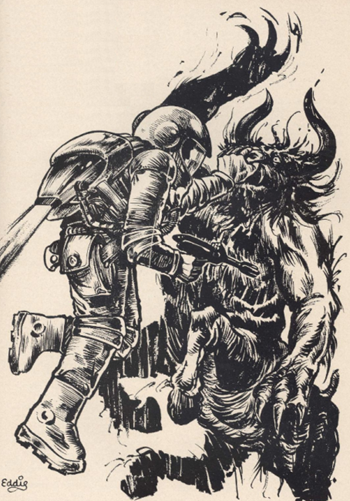
Illustrated by Eddie Jones
The final piece is by a new writer to me. The colony-ship Launcelot crash lands on Amor VII, killing almost ¾ of the occupants, including all the women. Another ship primarily composed of women also makes landfall, but contact is lost. From the Guinevere there start emerging minotaur like creatures that attack the men of Launcelot, what could have happened?
This whole piece is kind of a muddle, smelling to me of new author problems. The concepts are good and the point an interesting one. At the same time the action sequences are well written. The problem is structural. For such a small piece too much time is spent in irrelevant sections and the more poignant parts are rushed.
It is not bad though and I hope that Mr. Whitta can sort the issues out in the future.
A low Three Stars
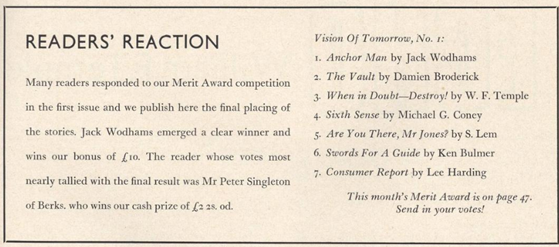
Story rankings from issue 1, my main surprise is seeing the fascinating Lem below the woeful Coney, but each to their own.
Fantasy Review
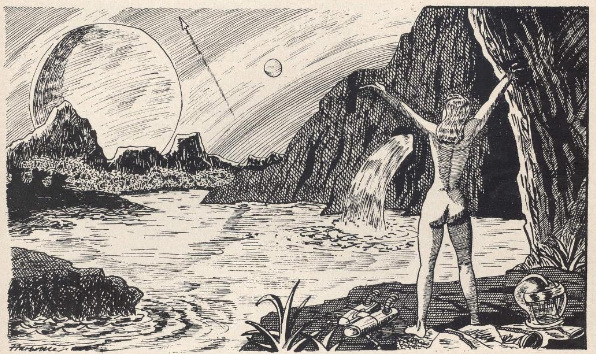
Illustrated by Philip Harbottle
Ken Slater reviews Timepiece by Brian N. Ball (which he did not enjoy) and Harry Harrison’s Deathworld 3 (which he did). We then have a new reviewer, Kathryn Buckley, covering Stand on Zanzibar in a highly complementary manner. Perhaps trying to balance coverage of the New Wave along with the Good Old Stuff?
Best of Both Worlds?
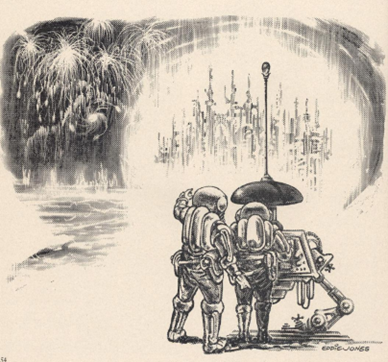
Additional illustration by Eddie Jones
In both my SF and my music, I am generally drawn towards the future facing experimental works, preferring Colosseum and Chip Delany over The Band and Edgar Rice Burroughs. But I also appreciate both have their advantages and place.
Doing a Sunday afternoon of gardening is wonderful accompanied by some Neil Young or Townes van Zandt. Just as an adventurous tale of daring-do might not be as accomplished as one of Ballard’s cut up stories, it can be a more fun and easy read.
So, whilst neither is perfect, with both the above publications showing successes and failures, I like to think that science fiction is big enough to have both our swashes buckled and our minds expanded.

by Victoria Silverwolf
A little more than a week ago, something remarkable happened in a small town in the state of New York. Depending on your point of view, it was either a gathering of joyful people sharing fun and good music, or a mob of filthy hippies stoned out of their minds and destroying their hearing with loud noise. Let's go back in time a little bit and try to figure out how this all came together.

Poster designed by Arnold Skolnick.
The Woodstock Music and Art Fair took place in Bethel, New York. That's about forty miles away from the town of Woodstock. Why the name? Thereby hangs a tale.
Early this year, some business folks planned to hold a big concert in Woodstock. They even called their company Woodstock Ventures. Long story short, local residents rejected the idea. The people running the thing tried other communities in the area. The authorities of the towns of Saugerties and Wallkill nixed the idea as well. What to do?
Enter a fellow named Max Yasgur. He owns a six hundred acre dairy farm In Bethel. He agreed to lease the use of his property for the festival in return for something like ten thousand bucks.

Yasgur's farm.
Some local residents were not pleased at all. (Rumor has it that Yasgur is himself a conservative Republican. Apparently that didn't prevent him from accepting money from members of the counterculture.)

A sign posted when the deal was announced.
Despite opposition, the authorities granted the necessary permits. (By the way, the reason the poster shown above mentions White Lake as the scene of the festival is because White Lake is a hamlet within the town of Bethel, and is about three miles from Yasgur's farm. Don't ask me; I'm only used to hamlet being the title of a famous play.)
It took so long to find a site for the festival that the folks running the thing didn't have time to put up fences or ticket booths. Heck, they barely had a chance to put up the stage! They'd already sold 186,000 tickets in advance (despite expecting only about 50,000 people to show up.)

Full admission price to the entire festival. Expensive!
The big show was going to start in the early evening on Friday, August 15. By Wednesday, the expected 50,000 folks had already shown up, with no way to find out if they had purchased tickets or not. A lot more were on their way. At its peak, the crowd was estimated at 450,000.

Roads leading to the area were jammed with would-be attendees. Recent rain turned fields into seas of mud. Lack of facilities — food and water, first aid stations, sanitation — added to the chaos.
Three people died at the festival. Two were from drug overdoses. One teenager was run over by a tractor while he was in his sleeping bag. Despite these tragedies, and many hundreds of people needing medical attention, one extraordinary fact stands out. There was not one reported act of deliberate violence at the festival.
Think about that. Close to half a million people living in close proximity, and in very stressful situations, without violence. Makes you wonder if these Flower People are doing something right, doesn't it?
Enough background. What about the music? Thirty-two acts performed, from early Friday evening to late Monday morning. Let's go over some highlights.

This advertisement doesn't list all the performers. There were also changes in the schedule. Sha-Na-Na didn't perform until Monday morning, and Iron Butterfly got stuck at the airport and didn't show up at all. Jeff Beck wasn't there, either.
The opening speech was delivered Friday evening by Swami Satchidananda Saraswati, an Indian guru. The first day was heavy on folk music performers, including Arlo Guthrie and Joan Baez (who is six months pregnant, by the way.) For me, the outstanding act was Indian sitarist Ravi Shankar.

Shankar performs Evening Raga.
Saturday afternoon until Sunday was when a lot of the most famous rock bands showed up. Santana, Grateful Dead, The Who, Jefferson Airplane, etc., but the electrifying performance of Janis Joplin and the Kozmic Blues Band, in the wee hours of the morning, was the highlight.

Joplin belts out an hour of her hits.
More rock music ended the festival, interrupted for about three hours by a thunderstorm. Monday morning the concert ended with two strongly contrasting acts, one looking backward and one offering hints as to what tomorrow's popular music might be like.
Nostalgia act Sha Na Na brought a chance of pace by performing doo-wop songs from the 1950's. (It's amazing how much pop music has changed in fifteen years or so!)

Performing oldie Book of Love in gold suits.
The final act was the amazing Jimi Hendrix, said to be the highest-paid rock musician in the world. His music is so far out, that it seems to be coming from the 21st century.

And yet he paid tribute to the past, with the wildest version of The Star-Spangled Banner you'll ever hear.
Was it worth all the mud and chaos? Despite the small number of tragic deaths, and hundreds of bad drug trips, most of the folks who were there would probably say it was. And here are some other eyewitness reports for you. Over to you, Walter…

Er… you're not Walter…

by Gideon Marcus
Woodstock: when it wasn't hot, it was cold. When you didn't have to pee, you were hungry. If you were anywhere near the stage (as we were Friday night into Saturday morning), you were elbow to elbow with a hundred thousand other people. I got less than 10 hours of sleep over the 72 hours of the event, and then I soldiered on to help clean up before crashing in the van.
It was the best weekend of my life.

Aftermath in Paradise
Look—I'm 50 years old. I've done a lot in my day, but I've never really pushed myself. I've never done drugs. I go to sleep by 10pm. I stay at home, except when I fly to Japan, and then I go first class…planes and hotels
For this adventure, there was none of that. The biggest concession to comfort is that we drove to the event early, and thereby avoided the worst of the traffic. And I surrendered my six square feet of ground near the stage to eat and excrete and nap in the comfort of our rented van (though I slogged back during the rainstorm Sunday afternoon and stayed through until the end of the event). It was a test of physical and emotional fortitude greater than any I'd had before.
What made it all worth it? The music and the people. It's all a riot of memories right now, a kaleidoscope that refuses to resolve, probably won't resolve for weeks or months:





It was an event for the ages, squared, cubed, and beyond for being shared with all of my closest friends. My life is forever punctuated into two eras: before and after Woodstock.
The papers already seem to be forgetting the festival, the city we built that, for a weekend, contained more people than the whole of Anza Highway corridor back home. But I'll never forget. We'll never forget.
We were there.

by Janice L. Newman
Even as we watched the opening acts, more and more and more people were pouring in, young and muddy and hungry. While others were focused on the stage, my mind couldn’t help but be consumed by something else: logistics.
How, I worried, were all these people going to get fed?
Fortunately, others had the same thought. By the time the second day was going strong, the Hog Farm commune, founded by Hugh Romney, Jr. (aka “Wavy Gravy”) had gone into action, requesting money from the concert organizers and using it to purchase thousands of pounds of rolled oats, sliced almonds, apricots, currants, bulgur wheat, wheat germ, and truckloads of fresh vegetables. “There’s plenty of food over at the Hog Farm,” a young woman told the audience. I had to see for myself.
So I left my spot near our van (I’d slept there through the first night, unable to stay awake even with Ravi Shankar and Joan Baez performing) and went to see what it was all about.

I spent the next four days going back and forth between Hog Farm and Woodstock, helping mix and serve muesli out of giant trash cans purchased for the purpose, handing out sandwiches, and watching as people patiently lined up and accepted their share, or stepped forward to volunteer to help, or passed food through the audience to their friends who refused to leave their spot near the stage. The food wasn’t hearty, but supplemented with the milk and yogurt from the dairy farm, it was enough.
I missed out on all the night concerts, even my twin-named Janis Joplin, but I was up early enough to catch The Who. The music was great, but more than that, I enjoyed the chance to be a part of something bigger.

Me at our campsite in the woods
The Age of Aquarius, one of brotherhood, peace, and universal love, has always seemed like a beautiful but naive dream. Yet we saw something like it over the course of four days. Not just in the young people who gathered, but the people who came together to help support, feed, and care for them and for each other. Even the US Army helped out!
Woodstock may not end up being a profitable endeavor after all that happened. It’s already being talked about in the papers as a boondoggle. And yet…it was something special. Something different. Something new.
The people in the audience weren’t just spouting words about peace and brotherhood, they believe it. In the face of such sincerity, cynicism melts away and hope can’t help but take its place. Who knows? Maybe this generation really will be the one to end war for good
.

by Lorelei Marcus
"How was Woodstock?" A friend asked me recently.
I couldn't reply for a long while, because there is no one answer; there is no one holistic Woodstock experience. Woodstock comprises moments, measured in music acts, naps, and meals. It was a lifestyle, a lifetime balled up into four days. How does one reply when asked "how is living?"
"Good," is all I could reply at the time.
Now I've had a bit longer to reflect. I can say that overall, it was worth it. But what was it like?

Me and mom at the campsite
It was the most humanity I'll ever see in my life. Everything from the funny guy teaching me about mushrooms, to the girl crooning out ballads on her tiny guitar between sets, to the practical feeling of wearing nothing along with everybody else. At some times we were a mass, snoring in the sun, lining up for food, eating, clapping, tripping, slipping on mud. Sometimes I was alone, relishing the quiet moment in the woods while I squatted over a hole, dozing through the first hour of Hendrix's concert, leaning over a pot of oats and stirring until it was warm.
There's a through line that connects these disparate flashes: the music. Some was transcendent, some was boring, and on the drive home I realized what made the difference. There were a lot of jams at this concert, not unusual for the live blues and rock scene, but often I found myself wishing for a song to end rather than enjoying its ride. Some would blame that on the sleep deprivation, but really, it's that long jams are flawed in two big ways.
First, a jam interrupts the flow of the song and diminishes the complexity of the experience. I don't mind the band free styling, but usually to keep together, they have to stay on one chord. This leads to a monotonous meandering of guitar notes and drum fields piled on top of a stagnant melody. The sound and the rhythm quickly lose their way, and any meaning built into the flow and structure of the original song are quickly dispersed.
The second problem is that jamming is a private experience. Songs are a story that reach from the musician to the listener. Jams can be like that if played with intention (Hendrix does this well), but otherwise it's a connection with one's band or even their own instrument. An audience can watch and appreciate technique, but cannot join the musician in their reverie without invitation.
Such is the art of performance, and what made both Janis Joplin and Sly and the Family Stone's shows so powerful. Both performers poured out their energy into the audience, giving themselves and their music to foster a bond. You could feel the passion like electricity in your bones. It multiplied, and you poured it out back to them, only making it stronger, looping until the music isn't just heard, but felt, like it's part of both of you. It creates a togetherness that you can't get anywhere else.

Me and Trini near the stage
Really, that's what Woodstock was all about: being together. Sometimes it was overwhelming, sometimes otherworldly, and mostly it was wet and loud.
But I wouldn't trade it for anything.

 The Seekers at the 1966 Royal Command Performance at the London Palladium
The Seekers at the 1966 Royal Command Performance at the London Palladium  On the cover of The Seekers first album, Keith Potger was replaced by former Seeker Ken Ray, because his day job as a radio producer at the Australian Broadcasting Commission barred him from involvement in a commercial enterprise. (L-R: Judith Durham, Ken Ray, Bruce Woodley and Athol Guy).
On the cover of The Seekers first album, Keith Potger was replaced by former Seeker Ken Ray, because his day job as a radio producer at the Australian Broadcasting Commission barred him from involvement in a commercial enterprise. (L-R: Judith Durham, Ken Ray, Bruce Woodley and Athol Guy).  Two tracks were released as singles, with their version of Australia’s unofficial national anthem “Waltzing Matilda” charting in the Top 40 in Melbourne, and the Top 100 nationally. Obviously, people did like to hear The Seekers singing what they liked, their way.
Two tracks were released as singles, with their version of Australia’s unofficial national anthem “Waltzing Matilda” charting in the Top 40 in Melbourne, and the Top 100 nationally. Obviously, people did like to hear The Seekers singing what they liked, their way.  Internationally successful folk acts like Peter, Paul & Mary had paved the way for The Seekers’ sound, the product of Judith Durham’s pure and powerful voice and the “nice harmonies” of the three men. With their clean-cut good looks, equally clean-cut voices and quiet dress, they appealed to English squares because they represented something they could understand and feel comfortable with, while at the same time their catchy tunes and soulful ballads, and their sheer musical talent attracted a wide range of audiences. The conservative BBC loved them, because their music contained no offensive lyrics, and their performances no outlandish behaviour, meaning that they received a large amount of air time on radio and television, which gave them wide exposure.
Internationally successful folk acts like Peter, Paul & Mary had paved the way for The Seekers’ sound, the product of Judith Durham’s pure and powerful voice and the “nice harmonies” of the three men. With their clean-cut good looks, equally clean-cut voices and quiet dress, they appealed to English squares because they represented something they could understand and feel comfortable with, while at the same time their catchy tunes and soulful ballads, and their sheer musical talent attracted a wide range of audiences. The conservative BBC loved them, because their music contained no offensive lyrics, and their performances no outlandish behaviour, meaning that they received a large amount of air time on radio and television, which gave them wide exposure.  In November 1964 “I'll Never Find Another You” became a massive worldwide hit, reaching Number 1 in Australia and the UK, and Number 4 in the US. It also rated highly in Europe and eventually sold 1.75 million copies worldwide. This earned The Seekers a place in the record books as the first Australian pop group to have a Top 5 hit simultaneously in the Australian, UK and US markets, as well as the first to sell over a million copies of a single.
In November 1964 “I'll Never Find Another You” became a massive worldwide hit, reaching Number 1 in Australia and the UK, and Number 4 in the US. It also rated highly in Europe and eventually sold 1.75 million copies worldwide. This earned The Seekers a place in the record books as the first Australian pop group to have a Top 5 hit simultaneously in the Australian, UK and US markets, as well as the first to sell over a million copies of a single.  The Seekers receiving their gold record in Australia for "The Carnival is Over"
The Seekers receiving their gold record in Australia for "The Carnival is Over" The Seekers during their first performance on the Ed Sullivan Show in 1965
The Seekers during their first performance on the Ed Sullivan Show in 1965 “Georgy Girl”, the title song for the film of the same name, reached Number 3 in the UK, Number 1 in Australia, and Number 1 on the US Cashbox Top 100 in February 1967, ultimately selling 3.5 million copies worldwide. Jim Dale and Tom Springfield, the song’s writers, were nominated for the 1967 Academy Award for Best Original Song of 1966, although The Seekers had to pass up the opportunity to perform at the awards ceremony due to a prior booking in the UK. Unfortunately for them, the Oscar was won by the title song of the film Born Free.
“Georgy Girl”, the title song for the film of the same name, reached Number 3 in the UK, Number 1 in Australia, and Number 1 on the US Cashbox Top 100 in February 1967, ultimately selling 3.5 million copies worldwide. Jim Dale and Tom Springfield, the song’s writers, were nominated for the 1967 Academy Award for Best Original Song of 1966, although The Seekers had to pass up the opportunity to perform at the awards ceremony due to a prior booking in the UK. Unfortunately for them, the Oscar was won by the title song of the film Born Free. The Seekers at the Myer Music Bowl, a publicity shot for "The Seekers Down Under"
The Seekers at the Myer Music Bowl, a publicity shot for "The Seekers Down Under" A scene from "The Seekers Down Under", showing the group in Canberra
A scene from "The Seekers Down Under", showing the group in Canberra The Seekers performing at the Australia Day concert broadcast via satellite to Australia from Expo 67
The Seekers performing at the Australia Day concert broadcast via satellite to Australia from Expo 67
 The Seekers made their last appearance together in a 50 minute television special on 9 July, rapidly arranged by the BBC. “Farewell The Seekers”, which has not yet been screened in Australia, was reportedly an emotional experience on screen and off, attracting an audience of more than 10 million viewers. When the lights went down, the carnival was over, and an amazing chapter in Australia’s musical history had drawn to a close. I wonder what will come next for the former Seekers?
The Seekers made their last appearance together in a 50 minute television special on 9 July, rapidly arranged by the BBC. “Farewell The Seekers”, which has not yet been screened in Australia, was reportedly an emotional experience on screen and off, attracting an audience of more than 10 million viewers. When the lights went down, the carnival was over, and an amazing chapter in Australia’s musical history had drawn to a close. I wonder what will come next for the former Seekers? 


by Mx. Kris Vyas-Myall
Last Summer I complained about the growth of “flower music” onto the charts in the UK. Almost as quickly as it appeared, it seems to have vanished again, apparently being a phenomenon over here only as long as it was 1967. In fact, there is barely anything that could be described as psychedelic in the top 40 singles or albums.

The only notable exception is “Fire” by The Crazy World of Arthur Brown, which is very different from the sounds coming out of California last year.
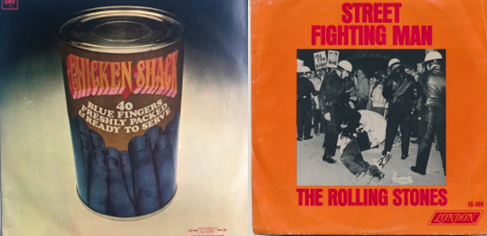
So, what has been replacing it? Well, firstly there has been a revival in the heavier blues sound, in both established acts such as The Rolling Stones and John Mayall, or new acts like Fleetwood Mac and Chicken Shack. Others seem to moving towards a pop sounding rock ‘n’ roll with heavy degrees of satire, the kind pioneered by The Kinks, we are now seeing on acts from The Beatles to Dave Dee, Dozy, Beaky, Mick & Tich.
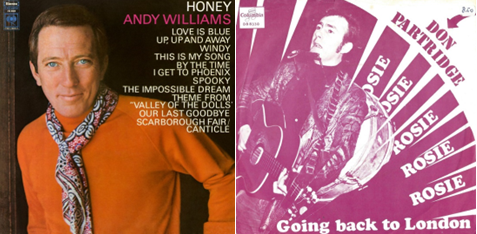
There are two genres that were also popular in 1967 that continue to be so. The first is the kind of Easy Listening music which predominates on BBC Radio 2, with figures such as Engelbert Humperdinck and Val Doonican. The other is folk music, which has much more variety in the charts, from the poppier sounds of Esther & Abi Ofarim, the more traditional route of Don Partridge or the curious experiments of The Incredible String Band.

But probably the biggest musical genre in Britain at the moment is soul music. Not just the continued success of American greats like The Supremes, The Four Tops or Ray Charles. But also newer acts such as P. P. Arnold, O. C. Smith and the orchestral sounds of Love Affair, along with established British Acts like Dusty Springfield, Lulu or The Mindbenders.
If anything, this goes to show how quickly musical tastes change nowadays. What was popular in the summer of ’67, ’66 or ’65 sounded decidedly old fashioned the next year. Where will tastes be in 1969? Only time will tell.
Whilst I was pondering this, a stunning new teleplay came on to Theatre 625 and gave us a glimpse into the entertainment of the future.
The Year of the Sex Olympics
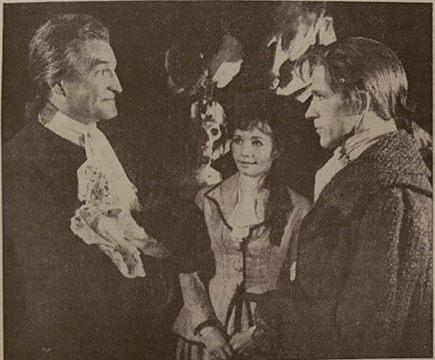
It has been a while for Nigel Kneale as a TV writer, working on films such as The Witches or First Men on The Moon instead. His last teleplay was half a decade ago with the excellent clever ghost story, The Road.
His teleplays have been known to be shocking and to provoke debate, sometimes even in parliament, and this is certain to carry on in this tradition.
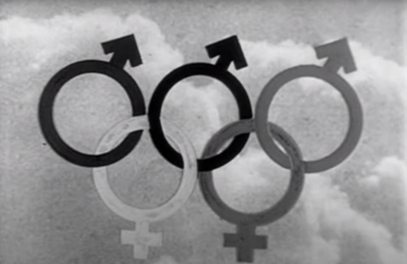
In a future clearly inspired by Huxley, the world now exists at peace and without want. Society is now divided into two groups:
There are a small group of “high drives” who we observe work in broadcasting and control the TV programs we see. Most people, however, are “low drives”. These people do not work, instead live in automated controlled environments. These do not have any interest in working and are kept pacified by the television programs the high drives produce.
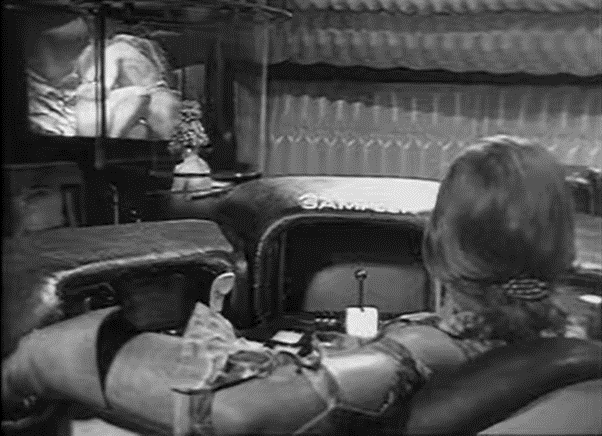
This society seems to be set up in this way for two reasons. Firstly, it keeps people pacified with the regular mantra, “Watch not do.” Sex television was designed to stop population explosion and wars, people numbed to doing anything by just seeing it all the time.
Secondly this acts as a form of eugenics to promote more high drives. With the sexual impulse of the low drives suppressed they are less likely to reproduce and most end up dying by the age of 35. Further tests are also done to determine if any high drive children are low drives and they are cast out into the audience.
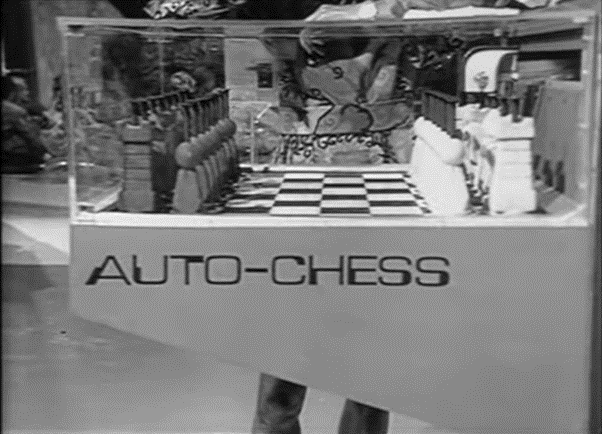
We are shown two problems with this situation. Firstly, some of the controllers are getting disenchanted with this society. Most notable is Kin Hodder, a set dresser, who is trying to introduce his real art into the broadcasts against the will of the controllers. The other is that the computers say they need to add more humour into the broadcasts, a concept none of the audience seems to be able to understand. For example, getting groups of clowns throwing custard pies only generates boredom.
Both problems are solved at the same time when the artist falls from a rope and dies in a gruesome manner, resulting in huge laughs from the audience. Thus is born a new concept: a show where people live on a remote island without any modern conveniences and are constantly filmed. Viewers get the thrill of never knowing if the participants will live or die. Two controllers, Nat and Deanie, volunteer for the pilot of the Live-Life show and bring along Deanie's daughter Keten.
Life is going to be much harder than they thought and, unbeknowst to the contestants, it turns out that the island is already inhabited. However, it will make for excellent ratings!
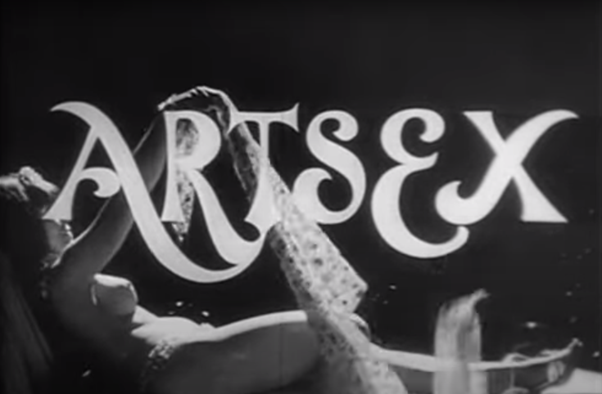
The dangers of television becoming more shocking for the sake of it seems to be a subject en vogue right now, for example Kate Wilhelm’s Baby You Were Great or the film Smashing Time’s You Can’t Help Laughing. However, having it on screen in this way is much more immediate and shocking.
The message is hammered home very hard throughout. Not just with the imagery but with the language as well, where we hear phrases such as:
“A censor stopped things from going too far. We stop when things don’t go far enough.”
This could seem as too didactic or curmudgeonly but it is a testament to Kneale’s skill that he manages to pull it off.
I have to wonder if some of this is also grumpiness at his own experiences of television. It is notable that “audience testing” is a big part of this future. Continuous calibration made to audience reactions and even the winners of competitions are based on this.
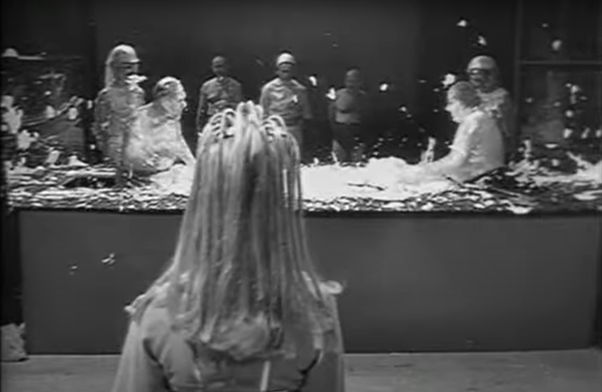
One of the odder choices is to give many of the (all British) cast American accents, something it does not appear they had much training on. This combined with the use of futuristic slang did make it hard to follow at times.
One person thankfully not trying to do one of these accents is Leonard Rossiter, a character actor probably well known to SFnal fans for his recent turns in The Witches and 2001: A Space Odyssey. He is an excellent choice for Coordinator Ugo, as he is able to come across as very unpleasant at the start whilst selling the disgust he feels at what is happening by the end.
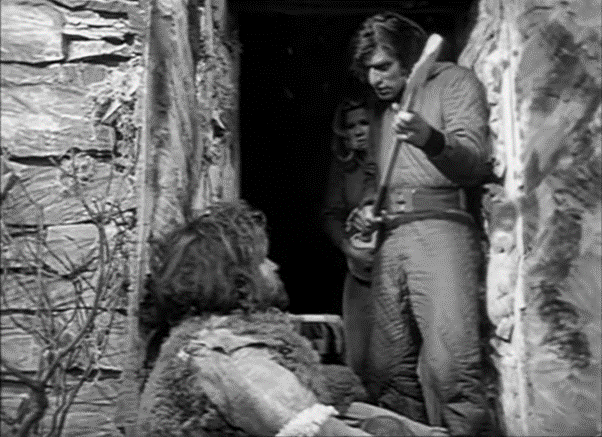
We do have to talk about the ending, as it is worth the price of admission alone. However, if you would rather wait for a possible repeat showing, stop reading now.
So, on the island Keten catches a disease that would be curable in the city, however, with no help available she dies. After the funeral Deanie is then brutally murdered by another inhabitant of the island who is then killed by Nat in revenge. This delivers the effect the controllers were hoping for as we see the audiences in raucous laughter over the horrific deaths and Nat’s grief.
This is disturbing enough but Nigel Kneale adds one final twist of the knife. Throughout we hear little jingles, very much in the style of pirate radio. Rather than having dramatic music playing over the ending, we just have a continual repetition of “The Year of the Sex Olympics Jingle”. Forcing us to ask, are we the same as them? Did we learn anything from what we saw or are we just as much passive participants?
If you missed it and are in the UK, write letters to the BBC asking for a repeat. If you are outside, see if you can convince a local station to import it.
Five Stars

by Erica Frank
Hair is a rapturous celebration of free love, higher consciousness, sexual adaptability, racial integration, and anti-authoritarianism. It's a critique of political corruption, the tragedies of war, and religious oppression. Also there is nature-based spirituality.
Hair is a debauched glorification of sex, drugs, perversion, profanity, and rebellion. It mocks public service, patriotism, and the church. Also there are fart jokes.
Pick one. Or take two; they're cheap. Everyone's got an opinion and none of them are the "real truth" about this complex and colorful stage production.
Note that the more positive description involves more words. It's easier to say something is bad–depraved, degenerate, vile, corrupt, and so on–than to praise something that doesn't fit into the established storytelling patterns of the day. And this musical–and its album–steps well off the common path to get its points across.
It's transcendental meditation versus the implacable forces of orthodoxy, and the prize at stake is the souls of a swarm of young people hanging out in Central Park.
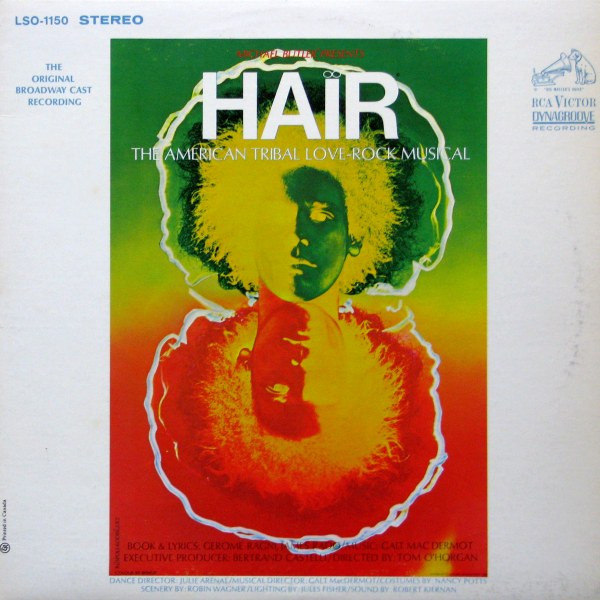
The cover is so striking you might not realize that the hair is not an artistic cloud-of-lightning addition–that's Steve Curry, who plays Woof in the Broadway cast.
Talk About Your Plenty, Talk About Your Ills
The music is incredible. From the opening "Aquarius" with its drumbeats and slow crooning that suddenly shifts to a cascading list of delightful assumptions of what the new era will bring, to the lascivious "Sodomy," to the jubilant "I Got Life," to the poignant "Easy to be Hard," the songs compel emotions with a shifting array of perspectives. The titular "Hair" is rebellious without hostility; "Don't Put It Down" is irreverent without contempt; "Three-Five-Zero-Zero" is stark and accusatory; "Good Morning Starshine" is bright and hopeful.
It's easy to get caught up in the music and miss the message–after all, the message is multi-directional and possibly contradictory. There's no one single theme I can point to and say, "this, this is the true message of Hair."
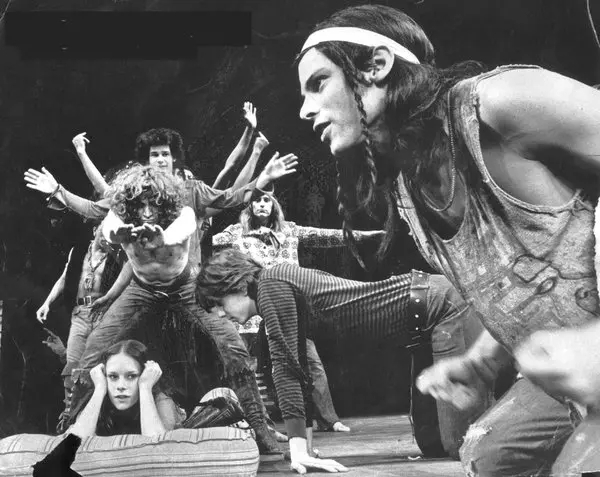
A scene from a performance last year, before the play hit Broadway.
It's anti-war, anti-draft. Those parts are simple enough. But it doesn't talk about war's influence on communities or even society–it talks about deaths of strangers happening far away, and young men who are afraid or (not unreasonably) unwilling to march off to fight and possibly die. This is not like Mark Twain's War Prayer; it's not a reminder that one side "winning" means another side enduring sorrows and agonies. This is instead, a view of war from the perspective of confused teenagers: A lack of comprehension why anyone would want to fight when the world seems on the verge of so many social and spiritual breakthroughs, when there is so much beauty and bliss and they could be partying instead.
War Is Not Healthy for Children and Other Living Things
Sheila leads the tribe in chanting for peace and freedom. Claude denounces his parents for coupon-clipping and wanders the streets looking at daffodils. Hud quotes Muhammad Ali from the New York Times last year, saying, "The draft is white people sending black people to make war on yellow people to defend the land they stole from the red people."
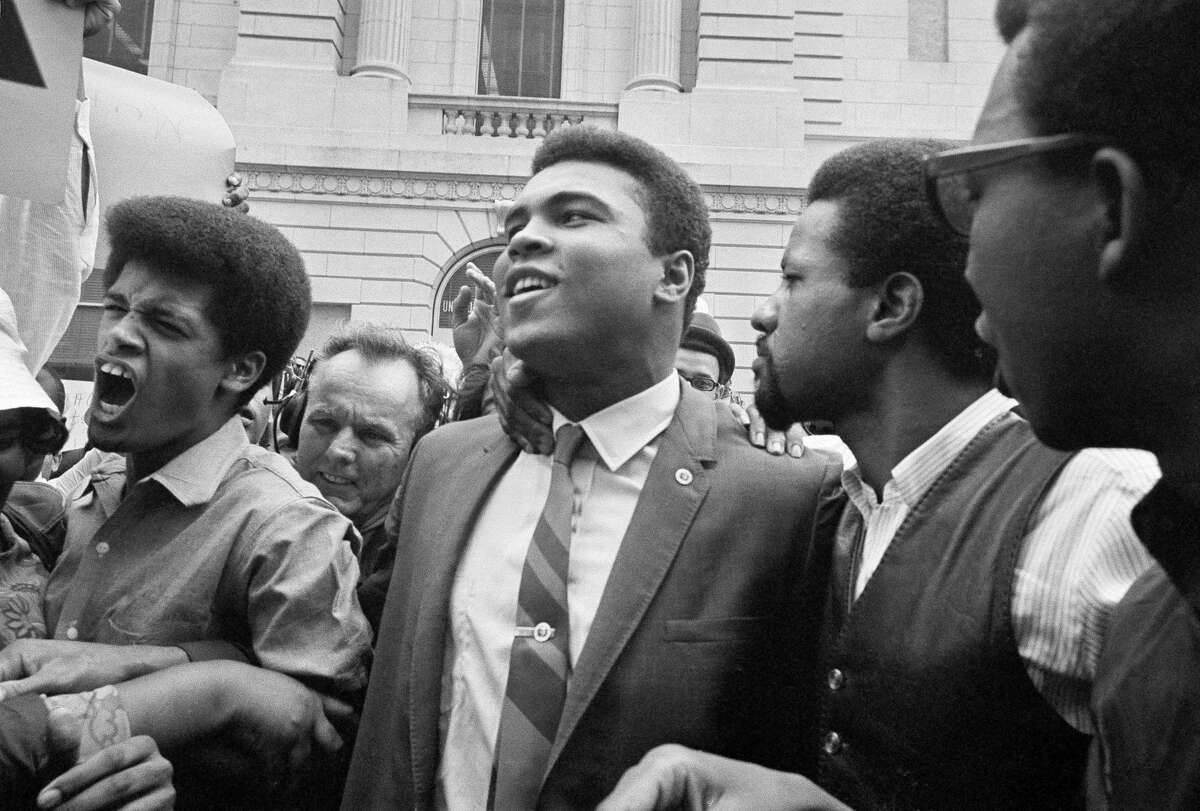
Muhammad Ali and friends leaving the Armed Forces induction center in Houston after Ali refused the draft – April 28, 1967. | AP
There is something very true about that. And yet it is also facile, a simplification of a complex political situation. It boils the draft down to "why is this wrong for me" without consideration of why one nation might take up arms on behalf of another.
I do not think the US should be in Viet Nam at all, and we certainly shouldn't be drafting soldiers to send there. But my reasons for these beliefs are not discussed in Hair, which is focused on its "haggle of hippies" and their interests, which do not include political theory.
The play is obviously, overtly anti-racist. It denounces segregation and discrimination, speaks out against the white historical practice of "colonizing" by killing anyone who get in their way. But it does so by having black characters proudly claim the slurs thrown against them as badges of honor, by showing native peoples as "noble savages," insightful and wise but speaking with broken English. It does not show that some black people are uncomfortable with gutter slang, and would like to be lawyers, doctors, or professors, rather than street dancers and "President of the United States of Love." It does not show that some people hold all Americans, not just "the Establishment," in contempt. It celebrates white girls dating black boys and vice versa; there's no equal jubilation over black people who want nothing to do with the communities of their historical oppressors.
It's not inaccurate so much as it's incomplete, showing only narrow aspects of multi-faceted problems, a view so limited it could reasonably be called deliberately misleading. It preaches that peace, love, and tolerance can overcome all conflicts, settle all disagreements, glossing over any disputes that have their roots in limited resources or incompatible cultural differences.
The Politics of Ecstasy
It would be easy to dismiss the play as a performance of Timothy Leary's admonition to "Turn on, tune in, drop out," and to say the "core" message is "ignore all the rules; just enjoy yourselves."
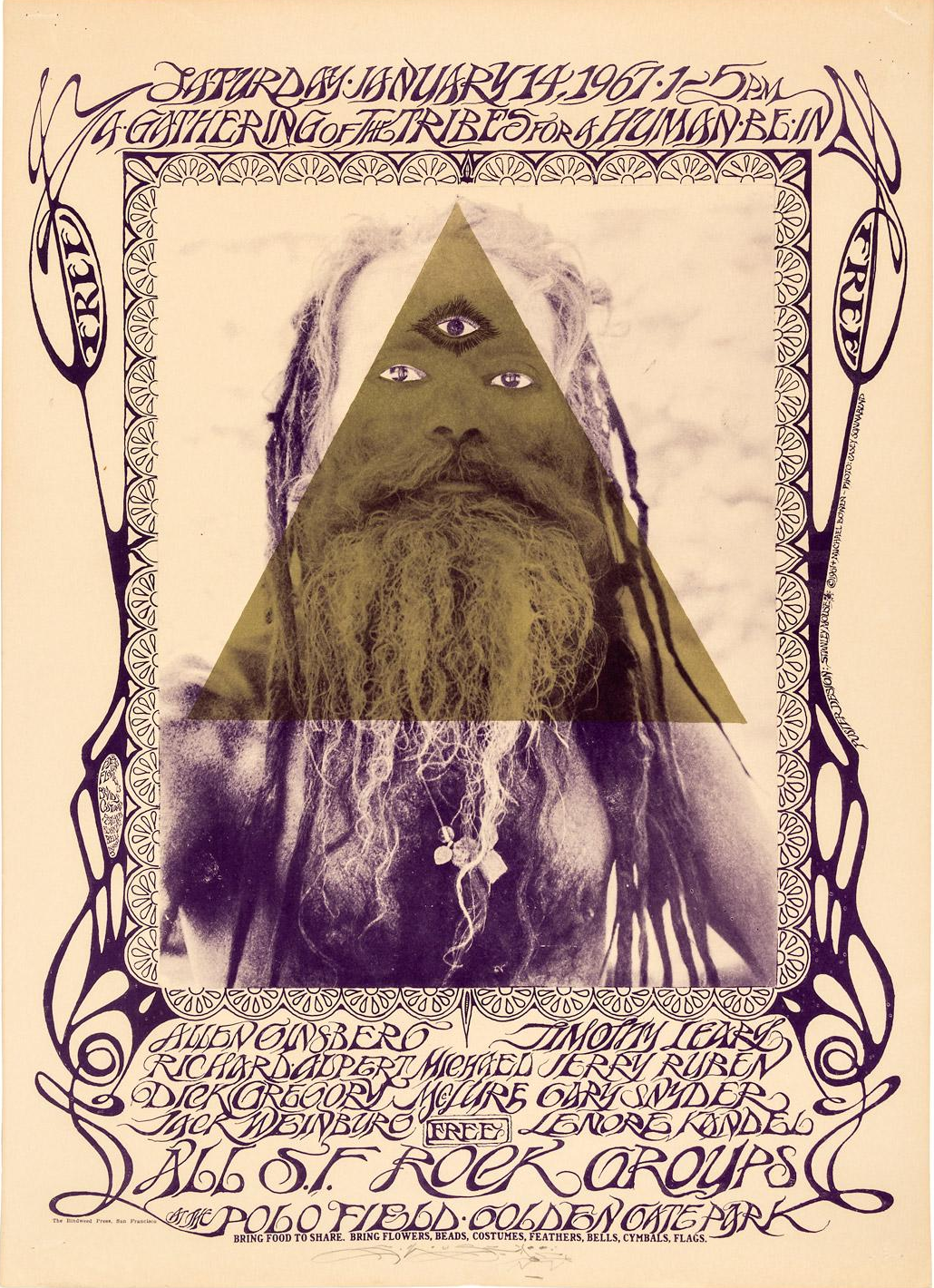
Poster for the Human Be-In at Golden Gate Park in 1967.
And while there's plenty to support that claim–lots of sex and drugs and, every time things get a bit too serious, Berger makes crude jokes–there's something deeper as well. The hippies wrestle with politics, survival, and their sense of self. They try to find their own identities in a community that's aggressively cooperative, in contrast with the large society that seeks to erase them.
For all the fun and festivities, there is a dark undertone that cannot be banished by any amount of song and merriment. As the story pushes toward the conclusion Claude fears so deeply, he is left with the awareness that, while his community will share his joys, they don't know how to lessen his worries or sorrows. We, the audience, are stuck also realizing that these cheerful, carousing people, who hug freely and seem devoid of jealousy or malice, are fighting an unwinnable battle against forces they do not wish to comprehend, because even naming the foe would lose the innocence that allows their tribe to exist at all.
Five stars. The highs are lively and charming, and the lows are breathtakingly bleak.

by Victoria Lucas
Definitions
The dictionary says there are two definitions for the word "transport." One definition we could use daily. A sample sentence might read, "The bus was my means of transport to the 5th Annual New York Avant Garde Festival."
Definition number 2 is quite different: "I was transported when I got on the ferry, but it wasn't by the transportation!" In this sense, one is overwhelmed with pleasure, joy, excitement, all those good things. How do you combine the 2? Why, at an annual New York Avant Garde Festival held on a ferry, of course–in this case the John F. Kennedy. 
Whee! Here we go. This was the list that got me going:

Charlotte Moorman, Producer
Right there at the top is the producer, Charlotte Moorman. Earlier this year Moorman was arrested and convicted of obscene behavior for playing the cello topless, apparently in compliance with the musical notation of a piece by Nam June Paik, one of the composers listed underneath the festival title. Fortunately the Commissioner of Marine and Aviation didn't know that when Moorman went to apply for a permit to use the ferry boat as a stage for dance, music, painting, happenings, etc. She got the permit, and when it was questioned by the press, the Department stood by their decision (bless them), and the festival went on.
She has been producing these festivals since 1965. Never a strident feminist (not that there's anything wrong with that), she has charted her course to be with like-minded musicians and performers, and she decided that it was pretty useless to have little concerts for herself and her friends–better to at least try to introduce the "avant garde" (read "strange") to an unsuspecting audience. Just look at the list of names! Allan Kaprow, Takehisa Kosugi, Jackson Mac Low, Max V. Mathews (Bell Labs electronic music!), Max Neuhaus, Sun Ra! And those are just the performers! Here is the program, listing the composers, painters, and so on:

Note, among others: Max Neuhaus, La Monte Young, John Cage (Yes!), Robert Moran (they played one of my favorite pieces, "L'apres midi du dracoula"), Robert Ashley, Toshi Ichiyanagi, Alvin Lucier, Karlheinz Stockhausen, with films by Stan Brakhage and "hopefully by" my favorite filmmaker Bruce Baillie, as well as Shirley Clarke and Ben van Meter. Con Edison lent them cables to use for all the electrical and electronic appliances/instruments, and somehow the Judson Memorial Church (where I went to see John Cage) was involved.
We were crushed!–uh make that IN a crush
Even after seeing partial lists of the performers and creators, I was not, however, prepared for the unique part of this experience. I've seen some of these people, heard their music, seen their work, read about them elsewhere. They and their work are available elsewhere. On the ferry, they were available right in front of me. Sometimes I could hardly get past them, the ferry was so crowded (holds 3,500, and that doesn't count the cars on the lower deck). There were dancers on the outside benches moving with a rope among them; Paik had televisions stacked on one another and on pedestals; a painter made room to paint in one area, a jazz combo to play in another. You could hardly move for the musicians, composers, painters, dancers, readers, poets, filmmakers, and all manner of creative men and women. "Excuse me, Mr. Ginsberg, could I get by you? I really need the john." Yes, Ginsberg did plan to be there. On a larger, longer, bluer than blue program for the event, his name is signed along with that of John Cage, Yoko Ono, and 107 others!
Here's how it went: Mel and I arrived and pushed our nickels into the turnstile slots. I can't remember what time we got there or how long we stayed. We probably stayed until the evening, not too late, because we don't want to be on the mean streets too late. We made our way onto the boat but there was no place to sit. We wandered around separately–a painting here, Nam June Paik's electronic display there. It really was shoulder to shoulder sometimes. I paid little attention to anything outside the boat. I think Mel tapped me on the shoulder at one point and led me outside so we could look at the Statue of Liberty. There were dancers outside, but no music. I was soon back indoors listening to music.
Come to think of it, I probably wouldn't have recognized most of the people on the program if they had addressed me personally. I know what Cage looks like, and he wasn't there when we were–or I couldn't find him in the press of people. I might have seen Nam June Paik adjusting the TV sets he piled one on the other. I have seen pix of Allan Kaprow and Yoko Ono–and I could maybe recognize a few others. But I didn't go to recognize people. I went to listen and look and be immersed in art and music. (I wasn't interested in the particular choreography on offer, but in reviewing the whole happening I would give it as many stars as I could reach.)
Back we went through the turnstiles and turned around and plunked in another nickel each and back into the crowd aboard. We were not allowed to stay on the boat. When it docked, we had to get off and pay for another ride. It was a routine–push our way through crowds to get on the boat, move around in it, 25 minutes later the boat docks, we get off and take the ride on the turnstiles, plunking the nickels (good thing we brought a supply) and getting on again, only to get off on the other side. It's a wonder we weren't dizzy. Actually, I think I was–dizzy with joy in art and music: Transported!


by Mx. Kris Vyas-Myall
It finally happened; the Golden Age of Pirate Radio has come to an end around the British Isles. After three and a half years of pop music coming from the high seas, they have (almost) been completely silenced. British music fans are primarily reduced to listening to middle of the road requests on Housewives’ Choice or popular songs as interpreted by the BBC Scottish Radio Orchestra.
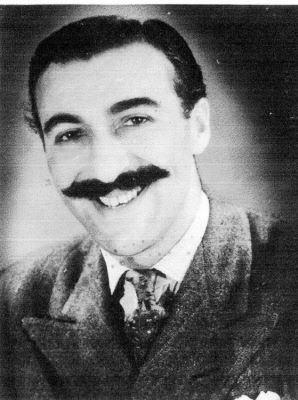
So how did we get from the country being surrounded by radio stations back to 3 BBCs stations and a signal from the continent?
Journey Out of Limbo
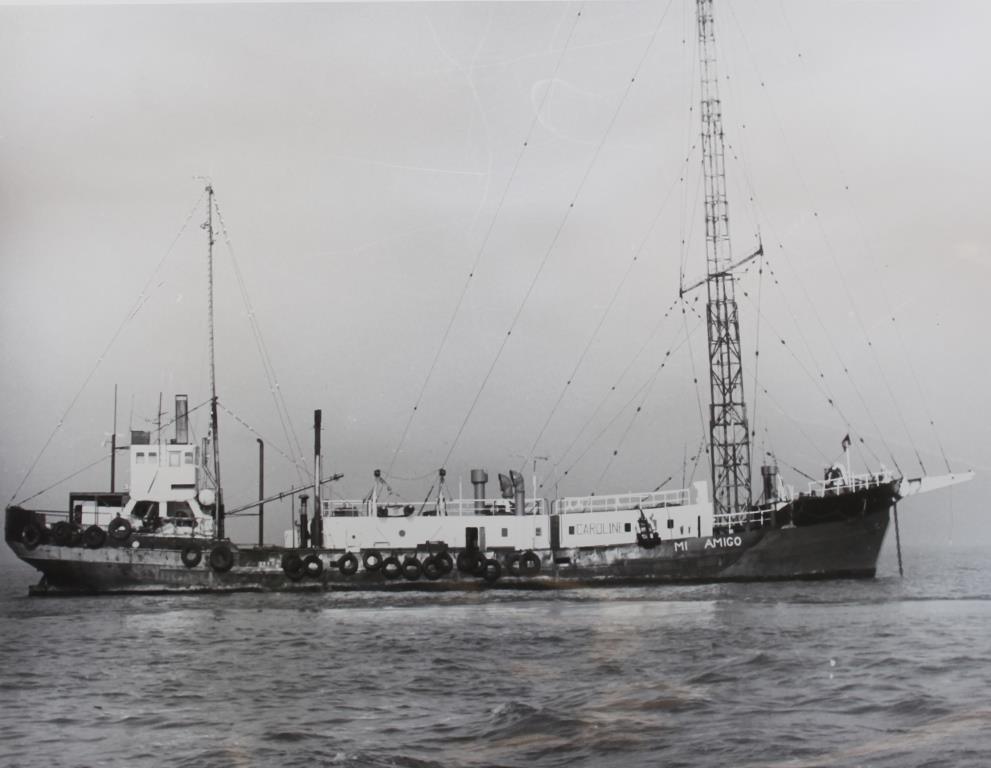
The legal loophole that Pirate Radio had operated in was not one that could continue on indefinitely. As I noted in my first article back in 1965, the UK was a key signatory of European Agreement for the Prevention of Broadcasts transmitted from Stations outside National Territories and so had to find a way to bring things to an end.
There had also been complaints from various different directions about these broadcasts:
* Foreign embassies were complaining that the signals were interrupting official broadcast channels (although others have claimed those signals were coming from behind the Iron Curtain)
* Shipping companies made the case that the pirate ships did not have set routes nor pre-agreed transmission frequency so were a hazard to transport
* Musicians unions argued that the amount of gramophone records played meant their live performances were being impacted
* Some record companies complained they were not receiving royalties from these stations (a fact that is disputed)
It also probably did not help when Reginald Calvert, owner of Radio City, was killed by Oliver Smedley, the former owner of rival station Radio Atlanta, in a row over transmitter parts in June of ’66.
So, a solution needed to be found. Obviously, the Pirates wanted to move towards legalization of their activities. I think you would have been hard pushed to find DJs that enjoyed being on rusty old ships or hanging out in abandoned sea forts, and the move towards an American style proliferation of commercial radio stations was probably their preferred option.
This was the proposal presented by Paul Bryan MP: to try to have around 200 local commercial stations throughout the UK, with major cities able to enjoy a choice of seven or eight different channels if there was enough demand.
Public show of support
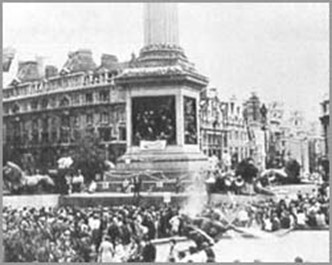
The Pirate radio groups have been trying to drum up support for their cause in various ways. These have included measures from a single, We Love the Pirates, to a letter writing campaign to MPs, to the Free Radio rally in Trafalgar Square at the end of May.
Perhaps the most audacious has been the attempts to influence politics. During the April council elections in London, ads were run in support of the Conservative Party on Pirate Radio (due to the party’s support of legalization of commercial radio) and subsequently the Conservatives won 82 out of the 100 seats. Not only was this the first time they had held control of the London council since 1931, it is also the largest majority held by one party in the council’s almost 80 year history.
Political show of Opposition

Edward Short, Postmaster General
If the Pirates and the Free Radio Association thought this kind of activity might exert pressure on the Postmaster General, Edward Short, they were sorely mistaken. If anything, it seemed to harden attitudes, with questions raised of whether further legislation was necessary to prevent any other kind of political broadcasting. Legislation has also been included to make it an offence for writers and artists to provide any kind of material or for the preaching of sermons on unlicensed radio (nicknamed “plastic gospels”).
Even a compromise proposal from Left wing MP Hugh Jenkins to allow for a smaller number of local commercial stations under a public authority, acting as a parent station, was rejected. Instead, the Marine Offences Bill or Marine Broadcasting (Prevention) Act was passed, making it illegal for anyone in the UK to provide any kind of support to these pirate radio stations. The law came into force on 16th August.
By then almost all the pirate radio stations had been shut down. Some had already begun to close earlier in the year, with advertisers wanting to jump ship before legislation went into effect. Others were able to survive a little longer, due to space being bought by the tobacco industry (who used it as a way to get around restrictions on their industry) and right-wing groups such as the Monday club (for whom this has become a cause célèbre).
However, as the deadline got closer, stations began to realize the game was up. The government had already begun to bring prosecutions where they could claim broadcasts had happened in British waters and rather than face a clampdown, they are silent. Now ships are being sent the scrapyards and forts are being dismantled.
There was even an investigation of the Amateur Athletics Association for making use of free advertising space on Radio Caroline. Although no prosecution followed I think this shows how strongly the government has taken the job of stopping the Pirates.
However, there is one last station determined to find a way to fight on…
The Rights of Man
As I noted previously, there are two legal radio stations you can try to listen to, if your signal allows. The night broadcasts of Radio Luxembourg from the continent, and the low powered broadcasts of the UK’s only legal commercial station, Manx Radio.
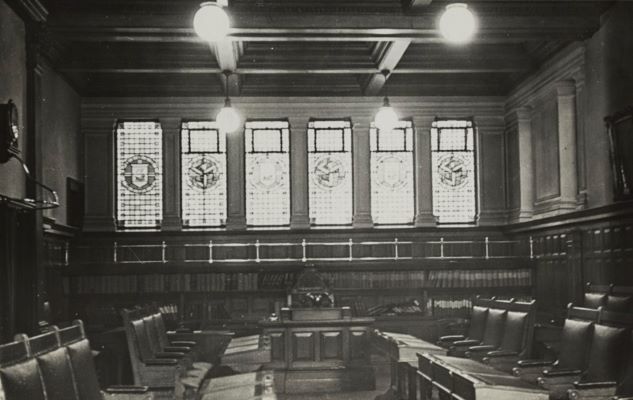
The Isle of Man’s relationship with the UK is a complex topic I could easily do an entire article on itself, but needless to say, the Tynwald (Manx Parliament) objected to the imposition of this legislation on an island with its own commercial radio station and without any consultation and so it was rejected.
This created a constitutional crisis because it meant that Pirate Radio could simply park up and get the operational support they needed from an island just Sixteen Miles off the British coastline and have the perfect venue to keep broadcasting. Which is exactly what Caroline North did when they dropped anchor there in early August.
At the same time, proposals were discussed to significantly increase the power of Manx Radio’s transmitter, to be able to compete with Radio Luxembourg and cover most of Britain and Ireland.
As you can imagine this caused a lot of anger in Westminster, and talks were held to try to resolve the crisis. Eventually the legislation was forced to come into effect at the start of this month. Plans for an extended transmitter are shelved and Caroline North is once again isolated (although they say they are stocked with supplies and will continue broadcasting).
On the other side of the country, Caroline South is officially operating out of The Netherlands, with several DJs moving there to avoid any risk of prosecution. How long this tactic will last is the question. The Dutch parliament is considering legislation similar to that of the UK, to come into force in 1968.
Common Ownership of the Means of Production
So, is that it? Pop music is banished from British airwaves? Not quite, whilst the government may be engaged in what Paul Channon MP called:
unreasonable, dictatorial, a killjoy, pettifogging socialist nonsense.
Mr. Short and Mr. Wilson are also not stupid. There is clearly a demand for pop music radio and if something isn’t done to address that fact, it won’t be long before other illicit means are deployed to provide it.
The government white paper came out in February outlining the new approach which, perhaps unsurprisingly for a socialist government, outlined the plans for a new national BBC pop radio station. This will broadcast at least six hours of records per day, along with live performances from the artists and special recordings. In addition, there are plans for 9 experimental local BBC stations, subsidized by local services.
This new radio station is to come in as Radio 1, as part of a reorganization of BBC Radio. The Light Programme (Light Music) is to become Radio 2, The Third Programme (classical) is to become Radio 3, and The Home Service (talk and scripted) is to become Radio 4. However, at least initially, no extra funds will be assigned to the radio service, so Radio 1 and Radio 2 will be sharing programming.
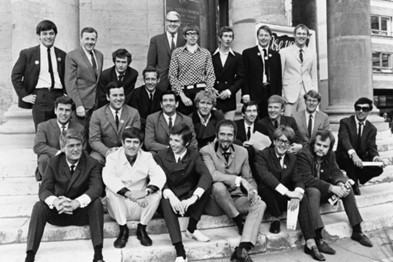
In a further sign of this as a form of nationalization, the new Radio 1 DJs are former Pirate Radio alumni, from big names like Tony Blackburn, to the hippy’s favourite John Peel. So, even though we may not be getting a continuation of multiple stations giving us 24 hour hit records, there will at least be some continuity.
Will the crown ever appeal as much as the Jolly Roger?
In 1718 over 200 pirates accepted the King’s Pardon and gave up their life of piracy. However, a number of them, most famously William “Blackbeard” Teach, soon grew bored and went back to a life on the high seas.
The question now remains, which way will things go today? Will the new “Radio 1” replace the Pirates in the hearts of the nation’s youth? Or will many of them follow Caroline’s lead and return to life under the Jolly Roger?
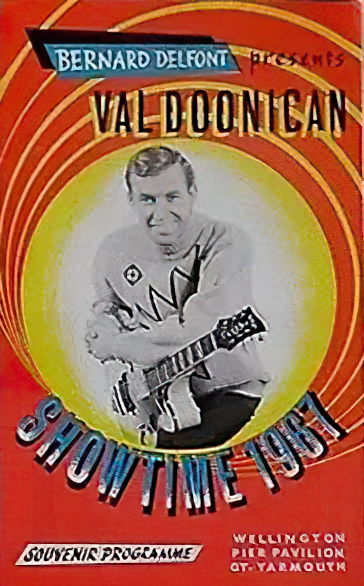
The new service debuts on 30th September. Until then, you will have to stay tuned to the Light Programme. As this issue is being stapled and sent out, you should be able to hear the sounds of Bernard Monshin and his Rio Tango Orchestra and extracts of The Val Doonican Show from the pier in Great Yarmouth …. groovy…

by Victoria Lucas
"The Man Come On the Radio"
Last time I visited this journal, I mentioned Pacifica Radio and how their broadcast of stories from Vietnam via the Christian Science Monitor is influencing my thinking on Vietnam. But KPFA and KPFB aren't the only public radio stations, and others contribute (read "sell") content to them. I'm thinking particularly of that non-mainstream star Bob Fass, of WBAI (New York).
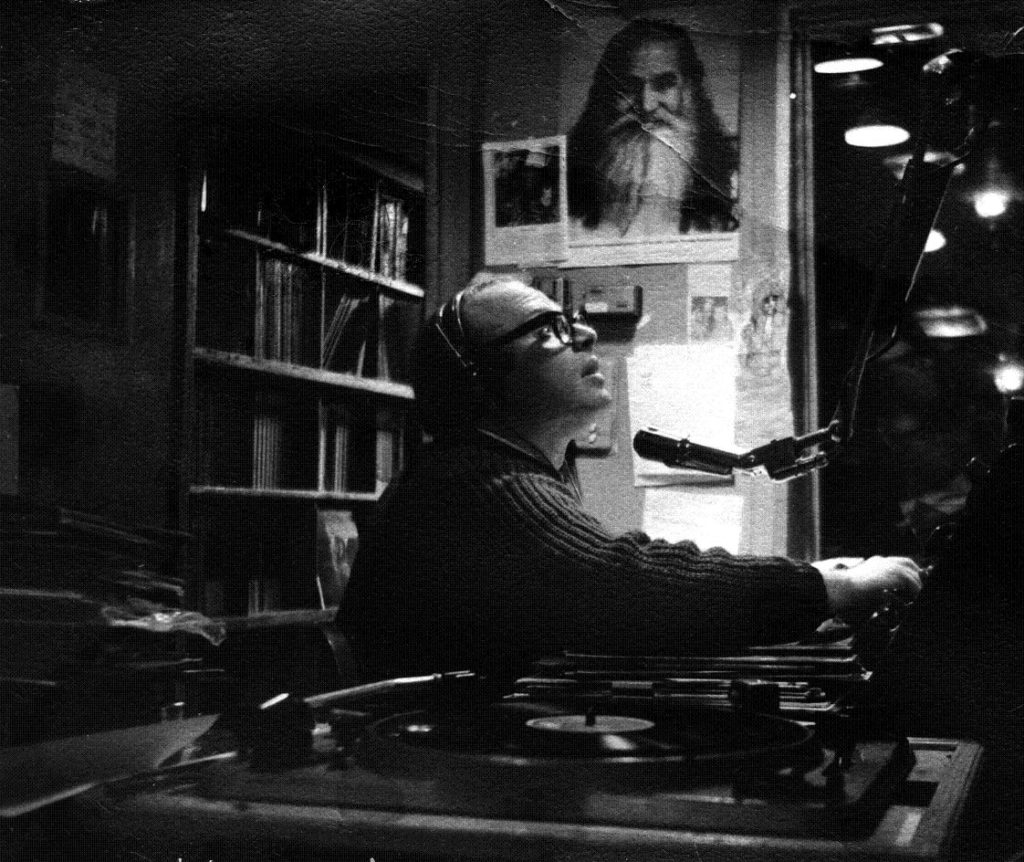
Bob Fass in the WBAI Studio, New York City
I can't get no "useless information"
I do love surprises–intellectual ones, not generally practical jokes. And Fass is full of jokes and japes and surprises. He's the kind of guy who would invite John Cage onto his show and play Cage's "Silence" (4'33") despite the rules against silence on the radio.It's no wonder his show is called "Radio Unnameable," although I had to look up the label, because I just turn on the radio and I guess it's lucky that I tend to turn it on when he's holding forth. Of course, the show is 5 hours long, emanates from the East Coast, and must be time-shifted, because he starts with "Good morning, cabal" at midnight in New York. So, for anyone tuning in from San Francisco after dinner, as I do, it's just there in the evenings weekdays starting at 9. (I miss him when he's off weekends.)
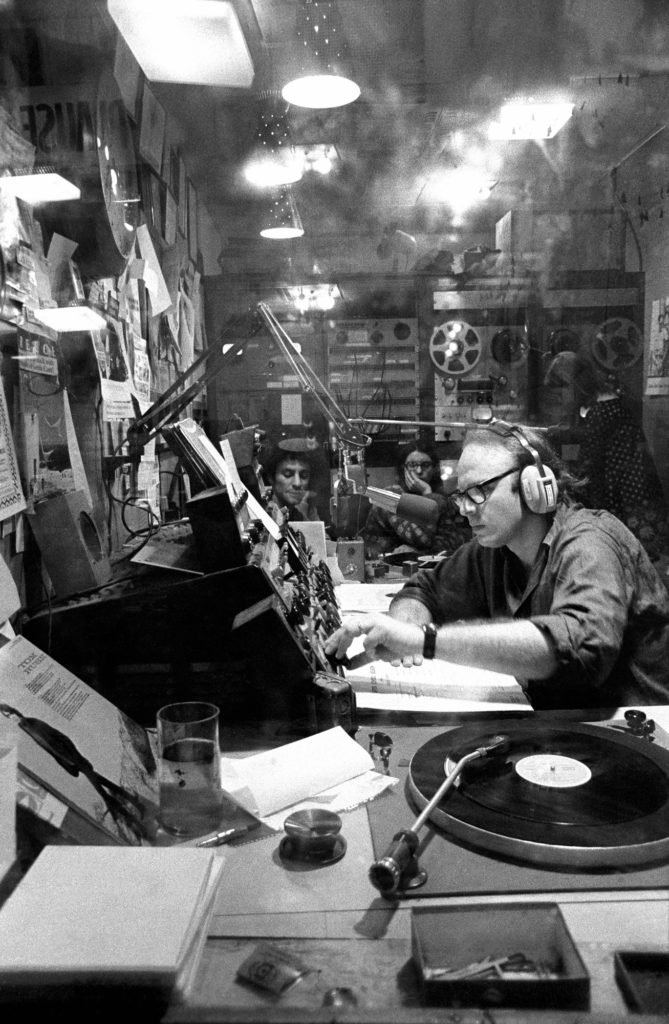
Fass with SNCC member, Abbie Hoffman
"Satisfaction"
What does he do with those 5 hours? Miracles. I think he would get LBJ on if he could. As it is, he satisfies himself with guests such as Abbie Hoffman, Paul Krassner, Richie Havens, Arlo Guthrie, Joni Mitchell, Allen Ginsberg, Frank Zappa, Country Joe, and many more, as well as random people who call in, sometimes more than one caller at once. Isn't that The Fugs playing right now as I write this? It doesn't matter how long or how short you make your song, you can sing it on his show. Someone you know having a bad acid trip? Call his show and he'll put on a psychiatrist to help you get through it unharmed (don't go outside unless you have a short walk to get help!)
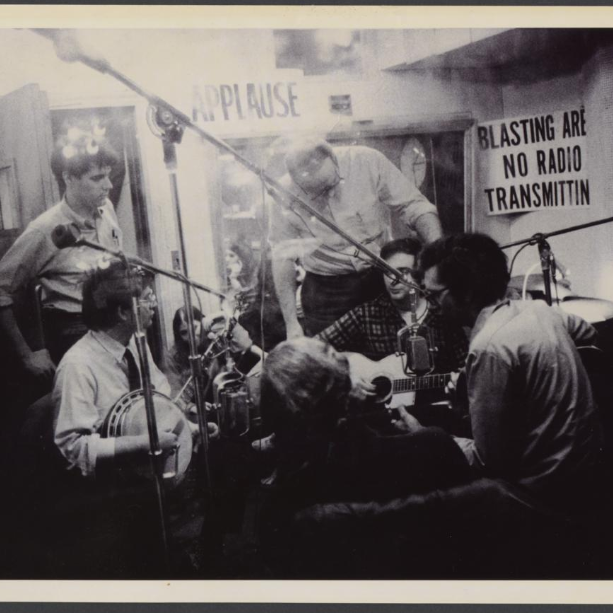
FM Radio at Its Best
"He Can't Be a Man"?
Did I forget to mention that we're talking FM radio here? I recently went into a store to buy a new radio when my old one bit the dust. The salesperson who sprang upon me while I was innocently browsing among the machines wanted to sell me an AM/FM radio. I said no, that I intend to never move out of the range of an FM radio station. (And I almost never listen to AM radio.) Of course, like all the best laid plans of mice and men, who knows what will happen. For now, Mel and I are eating the occasional bit of shark meat on our hibachi that we put outside on our tiny porch, with some vegetables & rice cooked inside on the stove where he sometimes has to warm up his head when his pseudomigraines start. And going to see Carol Doda on Broadway, the occasional experimental movie, play and so on. There is so very much to do here in SF besides radio! But yes, I can get "Satisfaction," on the radio and elsewhere.
Speaking of radio, Bob Fass would be right at home at KGJ, our radio revolution!

by Gideon Marcus
It's been three years since our last survey of the American music scene. When last we took the pulse of Top 40, music was in a weird in-between stage with a dozen different genres and influences competing for ascendance. What we didn't see back then was the great tidal wave of musical influence that was about to crash on our shores from across the Pond. I think it's safe to say that 1964 was a watershed year, and the pop scene at least can be divided into the eras BBI and ABI…
The British Invasion

The tip of the spear was, of course, The Beatles. The right combination of talent, variety, and infectious tunes, all in a slick gray-suited, mop-topped package, the Fab Four were a hit in the U.S. from the moment they appeared on the Ed Sullivan Show in February '64.

What made The Beatles so compelling was that they had so much to offer. From their surprisingly diverse debut album, to their rocking second album, and on through their movie soundtracks, A Hard Day's Night and Help!, the British quartet had three score songs to enjoy, almost all of them hit-worthy.
And shoulder to shoulder with the boys from Liverpool was a host of other bands: The Dave Clark Five with their hard-hitting Glad All Over and Bits and Pieces, the delightfully varied and somewhat cynical The Kinks with hits ranging from All Day and All of the Night to the wistful Sunny Afternoon, the bluesy The Who with their anthemic My Generation, and The Rolling Stones, who certainly provide Satisfaction, Eric Burdom's soulful The Animals, the unusual The Zombies. More recently, The Hollies have impressed with I'm Alive and especially Look through any Window.

I enjoyed the sardonic A Well Respected Man quite a lot.

There are many Animals songs to choose from, but We Gotta Get Out of This Place is relentless!

Look Through Any Window blew us away!
Plus all the lighter Merseybeat gang, from Gerry and the Pacemakers to the goofy Freddy and the Dreamers, Peter and Gordon to Chad and Jeremy. The utterly gormless yet inexplicably popular Herman's Hermits. Not to mention the more musical theater-type stars like Petula Clark, Dusty Springfield, and Lulu.

Downtown is both upbeat and melancholy at the same time.
All in all, it's been a musical smorgasbord, so delightful that you almost don't mind how many former musical greats got cut off midcareer: who listens to Neil Sedaka or Rick Nelson anymore? And Elvis is barely hanging on.
Domestic Resistance
Nevertheless, the Yanks have both resisted and embraced the invasion. The Beach Boys have kept on plugging away since their 1962 debut with album after album, and they don't seem at all fazed by the foreign influx.
Motown remains King (Queen?) too: Acts like The Supremes, Martha and the Vandellas, The Four Tops, The Impressions, Dionne Warwick, etc. fill the Top 10 as often as any English band.

Stop in the Name of Love — we got Tony Randall, too!.

Sadly, Martha and the Vandellas were shortchanged to promote The Supremes — their Nowhere to Run To is a modern classic.
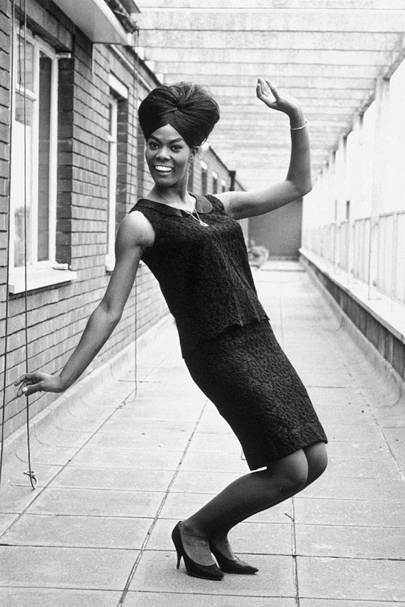
Walk on By is one of the loveliest songs ever recorded.
If there's anything that marks this era of music, it's how quickly it's changed. As doors open, they also close. 1964 saw the acme and crash of the surf guitar craze. Acts like The Ventures still steadily produce albums, but the rest of the scene has evaporated, again evolving into garage-y endeavors. The Chiffons, The Shirelles, The Ronettes, and many other girl bands have mostly dropped off the radar, Phil Spector's "Wall of Sound" being supplanted by the new raw aesthetic.
Folk to Folk Rock
Since the last wrap-up, folk music swelled to a crescendo and spawned a hybrid child with rock. In 1963, Bob Dylan hit it out of the park with his magnum opus, The Freewheelin' Bob Dylan. Though he continued in acoustic vein through 1964, by last year he had picked up an electric guitar, rasped his voice a bit more (yes, it was possible), and completely changed his sound. From Like a Rolling Stone to widely covered It's All Over Now Baby Blue, Dylan's harmonica-fused electrica has transformed the radio (whether you like it or not.)

Sure, there are still straight folk acts out there, including Joan Baez, Judy Collins, the superlative Donovan, and the recent Gordon Lightfoot, but rocking folk is where it's at.
To wit, The Byrds released two of the more exciting records last year, featuring the hits Mr. Tamborine Man and Turn, Turn, Turn. Those are good songs, although they have lots of others that I like as well or better. For instance: It's No Use, I'll Feel a Whole Lot Better, and It Won't be Wrong. The group's jangle and close harmony are really appealing, though their Dylan covers tend to be limp.
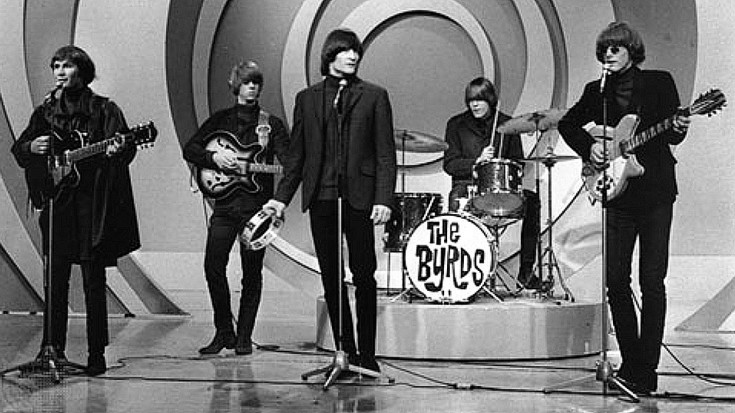
Then there's the appropriately named We Five whose You Were on My Mind was everywhere (and deservedly so).

We saw a great performance of it on Hollywood Palace last year!
Simon and Garfunkel released an acoustic folk album at the end of 1964 that was pretty good but went nowhere. Lorelei and I liked the song, The Sound of Silence, so much that we played it at coffee shops and gigs for a while. Apparently others shared our taste because the song got air play on a lot of college stations, and a Byrds-ified version came out in September, dominating the charts. The duo, which apparently had broken up, got back together to release a new album: The Sounds of Silence (natch). It's quite good, though a bit downbeat, and more than half the songs incorporate electric guitar.

And in the same realm are The Mamas and the Papas and the closely associated Barry McGuire, evolved from the purely folkishy New Christy Minstrels. The M & Ps' California Dreamin' is destined to be an anthem for the decade, and McGuire's controversal Eve of Destruction and his even more goose-bump inducing This Precious Time mark two of the absolute highlights for 1965.
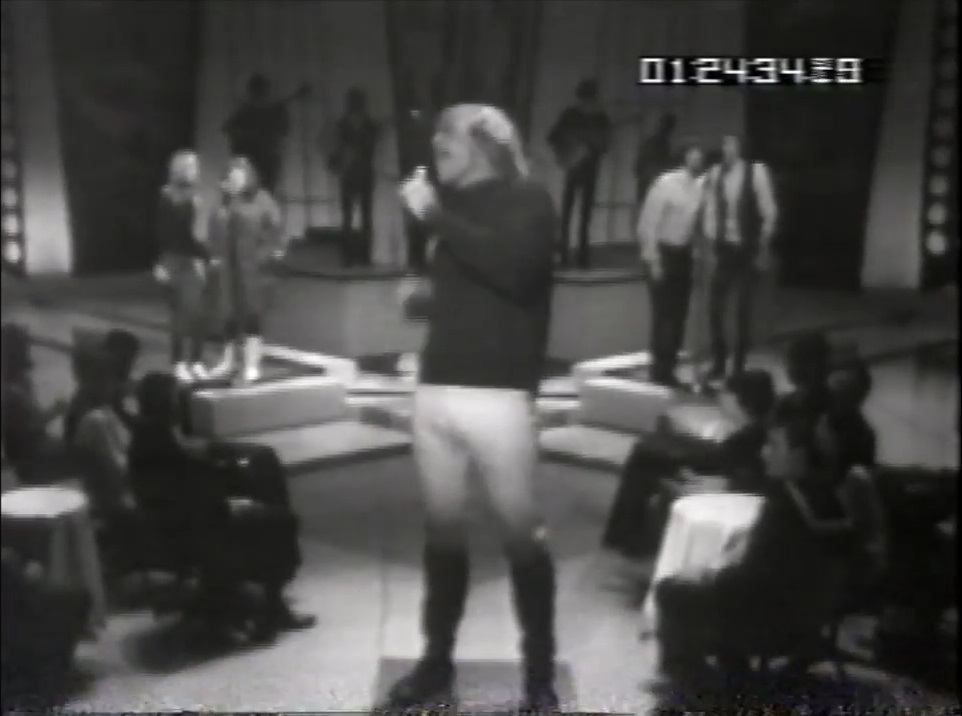
And we got to see BOTH of them on Hullabaloo late last year!
Given the success of the folk-rock genre, one can expect that the remaining "pure" folk acts may go in a rockish direction. But not necessarily…
Psychedelic
There's a new kind of music surfacing, filled with unusual effects, exotic instruments, and the impact of recreational drug use. For want of a better word, and because this is what several outlets and bands are calling it, the genre is "Psychedelic Rock."
Of all the bands I listen to regularly, probably the one that emblemizes this new style is the London-based The Yardbirds. Originally an uninteresting blues band, with the departure of guitarist Eric Clapton (who left because they stopped playing blues — don't let the door hit you in the a…mplifier on the way out) the band became something really far out. For Your Love, Heart Full of Soul, Still I'm Sad, and especially the latest single, Shapes of Things, are filled with atypical movements, eerie vocals, and just plain weirdness (but good weirdness) that indicates music has long since departed Kansas.

Other bands have begun experimenting with psychedelica, for instance, the formerly folk-rockish The Byrds with their brand new single, Eight Miles High. The frenetic, almost unfocused guitar work, the Indian inspired riffs, and the haunting vocals spell a huge departure from last year's output. The Beatles haven't whole-hog embraced the new style (yet), but the use of sitar on their last album, particularly on Norwegian Wood, is definitely part and parcel with it. I understand even The Beach Boys and The Rolling Stones are flirting with psychelica.
Next you'll tell me these bands are actually partaking! Le gasp!
Where to?
I don't think it's as hard to guess where things will be in 1968 or 1969 compared to how incomprehensible 1966 would have been to 1963 me. I'm guessing music will get weirder and heavier on one side, along a concurrent thread of smoother, poppish stuff. We might see two different radio formats arise by the end of the decade: one devoted to the experimental rock sound and one emphasizing smooth crooning and harmonies.
I sometimes marvel at how much I'm enjoying all of these new sounds. Many folks of my generation still cling to their jazz or even their classical albums and look at the new music as so much junk.
But to my ears, this is what I've been waiting for my whole life. Bring it on!

If you want to hear all of this great music, then tune in to KGJ, our radio station! Nothing but the newest hits!